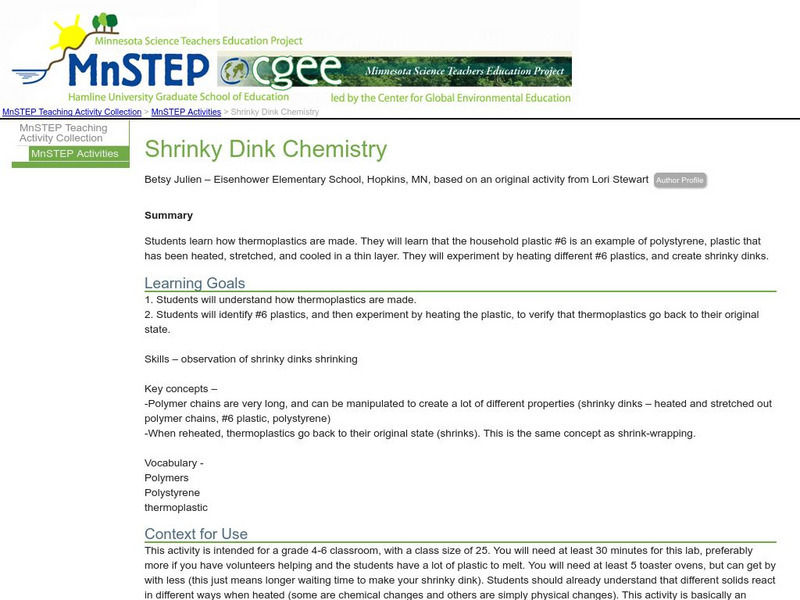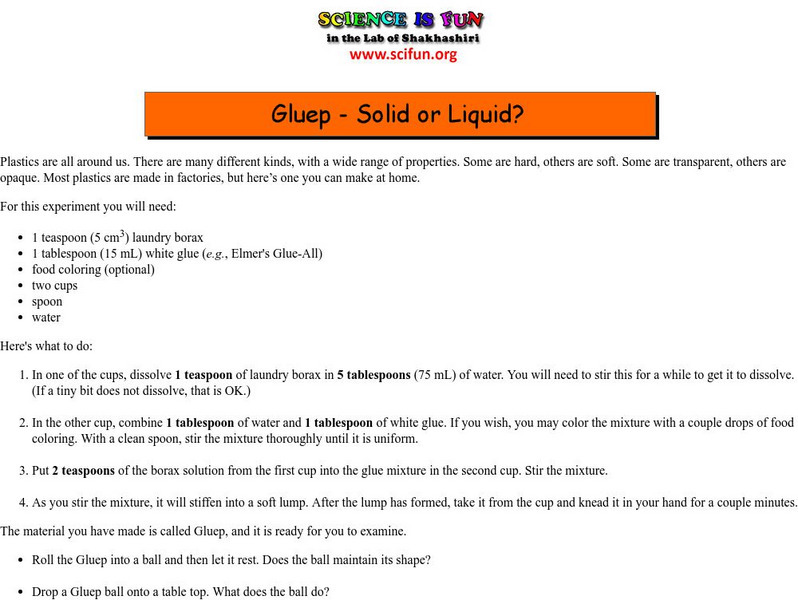Hi, what do you want to do?
Science Buddies
Science Buddies: Turn Milk Into Plastic!
In this hands-on lesson plan, students will conduct a simple milk-transforming experiment to explore how plastics can be derived from a natural resource such as milk.
McREL International
Mc Rel: Glue Polymer (Whelmer #15 Learning Activity)
An easy to do activity that investigates the basic principles behind chemical bonding. The activity is written in lesson plan format that meets NSES standards.
Math Science Nucleus
Math/science Nucleus: Polymer Storybook
This animation discusses polymers and the properties of polymers in a storybook format. The story covers polymers both plastic and natural, and provides interesting information.
Other
American Chemistry Council: Plastics: Basics: Polymer Definition and Properties
This resource provides information about what polymers are and their properties.
Science Education Resource Center at Carleton College
Serc: Mn Step: Shrinky Dink Chemistry
In this lesson, students first learn about thermoplastics, and about polystyrene in particular, which is a #6 plastic. They will then heat different #6 plastics to create shrinky dinks. As they are heated, they shrink, which is a...
Other
American Plastics Council: The History of Plastics
This site from the American Plastics Council provides a brief history of all major developments of fibers and plastics including the early invention of rayon. Very interesting and informative, it also includes a timeline for easier...
Science is Fun
Science Is Fun: Gluep Solid or Liquid?
In this experiment, students create a polymer substance called Gluep, then investigate its properties. Includes a detailed explanation of how the polymer molecules bond together to form the plastic.
Massachusetts Institute of Technology
Mit: Inventor of the Week: Leo Baekeland
Use this site to learn about how Leo Baekeland invented plastic, and how this simple invention resulted in a "plastic revolution."
Other
Libros Vivos: Los Plasticos
Plastics are obtained by polymerization of compounds derived from petroleum and natural gas. Learn about the different plastics and about the different process of fabrication in this site. You will find a lot of illustrations and...
Science Struck
Science Struck: Ldpe Plastic
LDPE stands for low-density polyethylene. This resource describes its structure, physical and chemical properties, resistance to various chemicals, advantages and disadvantages, uses, its BPA-free status, and the issue of recycling LDPE...
American Chemical Society
American Chemical Society: The Bakelizer [Pdf]
Find out all you want to know about the revolutionary development of Bakelite, the first plastic created entirely from chemicals. Included is a biography of the inventor of Bakelite, Leo Baekeland.
Other
Chemical Heritage Foundation: Leo Hendrik Baekeland
Leo Hendrik Baekeland was the inventor of bakelite, the first completely synthetic plastic. Biographical information and photographs on this page.
Other
San Diego Plastics, Inc.: Polyethylene
The features, applications, and the fabrication process of high density and low density polyethylenes are listed and described.
York University
Chemistry Hall of Fame: Polyethylene a Plastic of Many Uses
Background information on the discovery of polyethylene is found on this website. Also lists polyethylene's many uses.
Other
Prince Edward Island: Behind the Eight Ball
Interesting historical article about the driving force behind the invention of celluloid.
Wikimedia
Wikipedia: Polypropylene
This site from Wikipedia, the free encyclopedia, provides brief but factual information on the function of Polypropylene. A good site to get a short overview on the subject, with a few links to additional information.
Curated OER
Smithsonian Institution Archives: Jeanne Helen Osiecki (B. 1926)
A native of Switzerland, organic chemist Jeanne Helen Osiecki (b. 1926) had received her Ph.D. from Stanford University in 1960 and began working at Lockheed Missiles and Space Co. in 1961. When this photograph was distributed, Osiecki...













![American Chemical Society: The Bakelizer [Pdf] Handout American Chemical Society: The Bakelizer [Pdf] Handout](http://lessonplanet.com/content/resources/thumbnails/456091/large/bwluav9tywdpy2symdizmdeyny0xmte3mdk4lwcwy3uxni5qcgc.jpg?1674856933)




